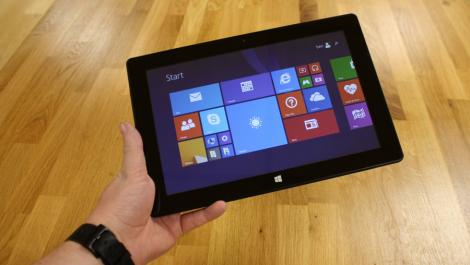
Introduction and design
I’ll forgive you for thinking that Windows tablets are still clunky, overpriced, and the ugly ducklings of the tablet market, as just a few years ago this was most certainly the case. Whilst they may not have caught up with the Apple iPad or some of the more pricey Android tablets around such as the fabulous-looking Dell Venue 10 7000, they are most certainly hot on their heels.
Now that prices have significantly dropped, and Microsoft has dumped the woefully prohibitive version of Windows that was RT, Windows tablets are starting to become a purchase that warrants genuine consideration for many people.
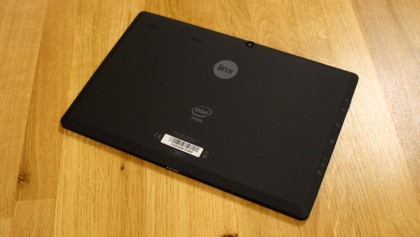
The Linx 10 is one of this new breed, and at £160 (around $238, or AU$307), is not the very cheapest 10-inch tablet around, but it’s not very far off at all. If you’re thinking it looks rather familiar, well, that’s because it is – the Linx 10 shares almost identical hardware with the Schenker Element 10.1 that we looked at back in September last year. Save for a minor spec bump in the processor department from a 1.33GHz Intel Atom Z3740D to the newer generation Z3735F, which can burst at faster speeds of up to 1.83GHz, telling these two tablets apart is a tough task indeed.
There’s also an 8-inch version called the Linx 8, which despite the smaller package, features almost identical specifications (apart from 1GB less RAM), and it comes in at a very appealing £90 (around $134, or AU$173).
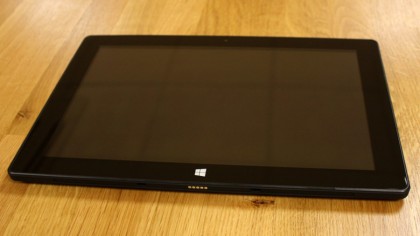
Design
Setting yourself apart from the rest is a difficult task in the overly saturated tablet market, especially when there are identical counterparts sold under other brands, but that doesn’t mean the Linx 10 isn’t a robustly put together bit of kit.
Apart from a small amount of give in the chassis on the left-hand side where all the ports are situated, the Linx 10 feels solid and doesn’t give off the vibe of a budget tablet.
Paired with the optional keyboard case which conveniently docks onto the foot of the tablet and holds it upright with an ingenious folding rear flap, this 10-inch variant of the Linx is most definitely an adequate replacement for the netbooks which were once so popular.
The front of the tablet is fairly non-descript: there’s simply a capacitive Windows button centred below the screen, and a 2MP front-facing camera above it. Next to the camera is a small red LED which does little more than light up when you turn on the tablet, and indicates when the front-facing camera is in operation.
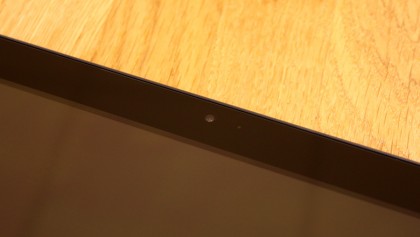
The left edge of the tablet is where all the action occurs, so things do appear a little crowded. Starting at the top we have the power/wake button, followed by a 3.5mm audio socket, mini-HDMI output, microSD card slot, micro-USB socket, microphone and the DC power socket.
In comparison to the smaller 8-inch Linx, the additional DC power socket is used to juice up the larger built-in battery, whilst the micro-USB socket is strictly for data only – Linx has had the foresight to include a USB ‘on the go’ cable so that you can plug in full-sized USB peripherals straight out of the box.
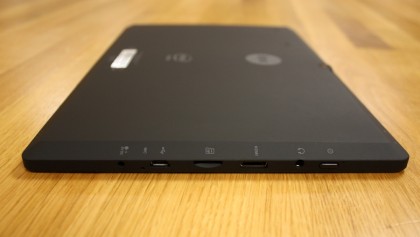
Linx has also chosen to increase the size of the HDMI output from the micro variant on the 8-inch model, to the mini version found here. Not that it really makes any difference – they both do the same job.
On the top edge, the volume bar sits at the very far left corner, which is easily accessible, and cannot be easily confused with the power/wake button – as is the case with many other tablets. I wish this device could have been given a more similar design to the Linx 8, as both the volume and power keys were significantly more tactile than on this 10-inch variant.
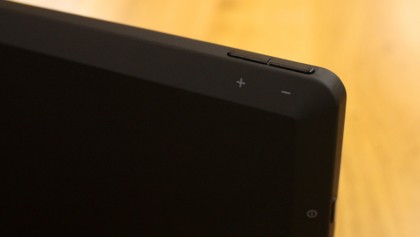
Turn the tablet round and you’ll find a rear with the same rubberised plastic that is often used on slightly more premium devices which feels tactile, and not too slippy. The Linx logo takes pride of place in the centre, with a 2MP camera just offset to the right. In the top left corner, two speaker grilles give away the positioning of the stereo speakers – an odd placement that is surely limited by the internal hardware, as they would have been much more welcome spaced further apart – or even up front instead.
Still, small niggles aside, the Linx 10 is a well-designed – but not particularly inspired – budget tablet.
Specifications
It may not be the thinnest tablet, or have the smallest bezels surrounding its 10.1-inch screen, but the Linx 10 still feels relatively compact, and is far from the chunkiest 10.1-inch Windows tablet around. Measuring 258 x 172.6 x 10.5mm (H x W x D), it comes in slimmer and not as wide as the Microsoft Surface Pro 2, albeit packing considerably less punch.
Here’s the full spec sheet:
- Processor: Intel Bay Trail-T Quad Core Z3735F up to 1.83 GHz processor
- Operating System: Windows 8.1
- Memory: 2GB LPDDR3
- Display: 10.1-inch 16:9 IPS HD (1280 x 800) with 10 point multi-touchscreen
- Graphics: Integrated Intel HD Graphics
- Storage: 32GB eMMC
- Camera: Front 2 MP and rear 2 MP
- Networking: Integrated 802.11a/b/g/n, Bluetooth v4.0
- Connectivity: 1 x mini-HDMI, 1 x micro-USB, 1 x microSD slot
- Audio: Built-in stereo speakers and microphone
- Battery: 7,900 mAh li-ion
- Dimensions: 258 x 172.6 x 10.5mm (H x W x D)
- Weight: 0.83lb (601g)
Performance
Benchmarks
- 3D Mark: Fire Strike: would not run; Sky Diver: 318; Cloud Gate: 898; Ice Storm Unlimited: 11,223; Ice Storm Extreme: 6,178
- CineBench 11.5: CPU: 1.08 (multi), 0.29 (single); Graphics: 4.55fps
- PC Mark 8: Home Test: 1,014; Battery Life: 10 hours
Much like its 8-inch equivalent, the Linx 10 packs a passively-cooled quad-core Intel Z3735F Bay Trail-T Atom processor, but surprisingly – unlike the smaller sibling – it actually idles at a lower clock speed of 1.33GHz, bursting to speeds of up to 1.83GHz. It’s exactly the same processor that features Gen7 architecture with Intel HD graphics that support DirectX 11, despite being clocked at a lowly 646MHz. In a step up from the similar Schenker Element 10.1 and Linx 8, the Linx 10 doubles the RAM from 1GB of LPDDR3 up to 2GB.
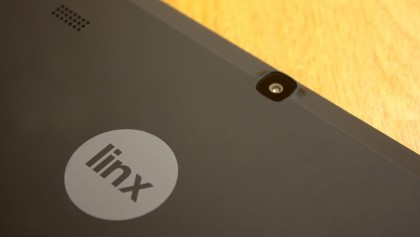
This means – above all else – that whilst it may be no more powerful in some respects, the marginally newer processor and additional RAM does show better performance in multi-tasking and some memory-intensive applications.
Onboard storage is available in either 32GB or 64GB varieties – I reviewed the 32GB version, which comes with 24GB out of the box, but only a little over 17GB available for storage. It’s very easily filled if you start installing fully-fledged applications. I managed to run out of space simply by installing the suite of benchmarking software I needed to use for this review. Of course, you can equip the Linx 10 with a microSD card of up to 64GB for a plentiful amount of extra storage, should you require.
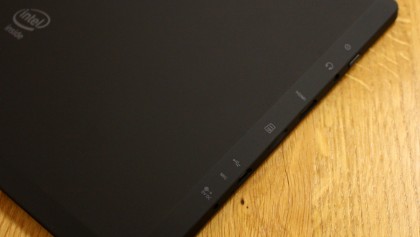
Screen quality is surprisingly good, if a little low-resolution. The 1,280 x 800-resolution, 10.1-inch panel makes use of IPS technology, which ensures good brightness, contrast and viewing angles, but the resolution feels a little limiting when viewing detailed web pages.
Turned up to the maximum brightness, the panel manages a pretty impressive 329cd/m2, but at this brightness, expect the battery life to easily run out around the six hour mark.
With the brightness turned down to about a third, it measures 120cd/m2, and at this point can easily break the 10 hour battery life marker – more than the quoted maximum of eight hours. Whilst the display is bright with good contrast, colour accuracy is not as good as I have seen on other tablets with IPS screens, with videos and photos lacking the vivid punch we’ve come to expect from AMOLED panels.
As I’ve found with most other cheaper Windows tablets, despite featuring a 64-bit Atom processor, the version of Windows 8.1 onboard is limited to 32-bit applications, meaning it doesn’t entirely make full use of the CPU’s capabilities. It’s an odd decision, and likely to be largely down to cost saving more than anything else.
Where benchmarks are concerned, the Linx 10 was a bit of a let-down compared to the Linx 8. The lower clocked processor meant that visual quality and the framerate on 3D Mark and Cinebench’s OpenGL test noticeably suffered, whilst Cinebench’s CPU tests and PC Mark scores were also lower, and only propped up by the additional RAM on offer.
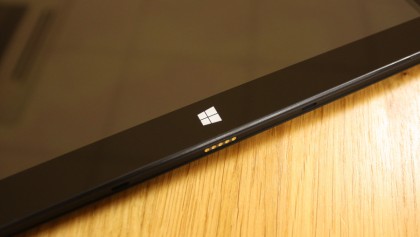
Bundled software
As you may have come to expect with the current generation of low-end Windows tablets, a year of Microsoft’s Office 365 is pre-installed, meaning that the tablet can be used as a genuinely productive PC.
Other than this single extra bundle of applications, there’s nothing else save for the standard suite of Windows accessories pre-installed. Of course, you can head to the Windows Store to find additional applications, but nearly three years after Windows 8 was first introduced, the selection is – at best – a relatively uninspiring affair.
Linx does offer 1TB of OneDrive storage, but I could find absolutely no details as to how long this cloud storage offer would remain in place. The company also advertises a £50 (around $74, or AU$96) cashback incentive when you trade in your old tablet, but on closer examination, this offer expired on March 31 on all but the 8-inch model (for which you’ll get £30 – around $45, or AU$58).
Verdict
Unless you are willing to spend almost three times the money on better specified, but far more expensive alternatives such as the Lenovo Yoga 2, there is little that competes with Linx’s keenly priced Windows tablets.
Yes, there is the previously mentioned Schenker Element 10.1 that looks almost identical, but it’s more expensive, lower-powered, and only available on the continent. Other than that, the Linx 10 is only really surrounded by budget Android tablets at the £160 (around $238, or AU$307) price point.
I was a little disappointed to find that the processor has been under-clocked, and can only assume that this was something to do with ensuring battery life remains at a reasonable level. Having used the higher-clocked 8-inch sibling, however, it simply doesn’t make sense. Outside of benchmark scores, the Linx 10 did seemingly perform well, and multi-tasking felt like it was a little less taxing with the extra Gigabyte of RAM onboard.
With the extra 2.1-inches of screen real estate, I’d be looking for a screen with a higher resolution if I were laying down the cash myself, as frankly anything below 1080p on a 10-inch tablet looks overly pixelated next to the super high-res smartphones we are now all so used to. Despite this lack of pixels, the screen was bright and had good contrast, even if the colours weren’t particularly vivid.
The USB ‘on the go’ cable included in the box is a thoughtful little addition – even if they do only cost mere pence on eBay these days. It means you can add much-needed extra storage from an additional hard drive, use a full-sized keyboard, printer, or any number of Windows-compatible peripherals.
We liked
Like its smaller sibling, the Linx 10 is a well-built tablet that offers a significant amount for a relatively small outlay of just £160 (around $238, or AU$307). It’s the perfect tablet for kids to browse the web safely on (thanks to Windows’ various parental controls), and get productive with the included Microsoft Office 365.
There is just about enough power to keep things running smoothly without any noticeable slowdown, thanks in part to the extra Gigabyte of RAM available in comparison to its rivals.
Plenty of connectivity comes as standard, with a mini-HDMI port, microSD card slot, and micro-USB socket with included USB ‘on the go’ cable all ready to offer up connectivity that rivals some laptops.
We disliked
Though it’s difficult to be too harsh on what is essentially a fully-fledged 10-inch portable PC for £160 (around $238, or AU$307), there are some areas of the Linx 10 that felt like a bit of a let-down, especially when compared to the Linx 8, which is another £70 (around $104, or AU$135) cheaper.
The processor showed that it’s not quite got the required grunt for any 3D applications, and I never once saw it reach the supposed maximum speed of 1.83GHz – even when running benchmarks.
In an ideal world I would have liked to see a higher resolution screen and most definitely more in the way of storage space, as the 32GB advertised storage capacity is anything but – only 17.4GB being available when you first turn on the Linx 10.
Final verdict
There may be a lack of overall grunt and the storage space is pretty pitiful, but for a casual web browser or producing documents, the Linx 10 feels like a great alternative to underwhelming netbooks that flooded the market only a few years ago.
For only £160 (around $238, or AU$307), you’re getting a full Windows PC that can run modern Windows Store apps and legacy 32-bit applications, as long as they don’t require too much space.
If you’re thinking that the Linx 10 might tick some boxes for you, I’d highly recommend investing a little more in the 64GB version (if you can find it for sale), or alternatively buying a 64GB microSD card to add some much-needed additional storage.
Keep an eye out for a bargain, and you might be able to pick up the Linx 10 for less than £150 (around $223, or AU$288), which starts to become very tempting indeed, especially when you consider the relatively uninspiring Android-powered alternatives that fall into this price bracket.
![]()
Related Posts
December 6, 2021
7+ Web Design Trends for 2022: Which Will You Use?
December 6, 2021
The 10 Best WordPress Booking Plugins to Use On Your Website
December 6, 2021
How to Use a Web Cache Viewer to View a Cached Page
November 6, 2021
10 Modern Web Design Trends for 2022
November 6, 2021
Best Free SSL Certificate Providers (+ How to Get Started)
November 6, 2021
How to Design a Landing Page That Sends Conversions Skyrocketing
November 6, 2021
What Are the Best WordPress Security Plugins for your Website?
October 6, 2021
Your Guide to How to Buy a Domain Name
October 6, 2021
How to Build a WordPress Website: 9 Steps to Build Your Site
September 6, 2021
10 Best Websites for Downloading Free PSD Files
September 6, 2021
HTML5 Template: A Basic Code Template to Start Your Next Project
September 6, 2021
How Much Does It Cost to Build a Website for a Small Business?
September 6, 2021
A List of Free Public CDNs for Web Developers
September 6, 2021
6 Advanced JavaScript Concepts You Should Know
August 6, 2021
10 Simple Tips for Launching a Website
August 6, 2021
25 Beautiful Examples of “Coming Soon” Pages
August 6, 2021
10 Useful Responsive Design Testing Tools
August 6, 2021
Best-Converting Shopify Themes: 4 Best Shopify Themes
July 6, 2021
What Is Alt Text and Why Should You Use It?
July 6, 2021
24 Must-Know Graphic Design Terms
June 6, 2021
How to Design a Product Page: 6 Pro Design Tips
April 6, 2021
A Beginner’s Guide to Competitor Website Analysis
April 6, 2021
6 BigCommerce Design Tips For Big Ecommerce Results
April 6, 2021
Is WordPress Good for Ecommerce? [Pros and Cons]
March 6, 2021
Make Websites Mobile-Friendly: 5 Astounding Tips
March 6, 2021
Shopify vs. Magento: Which Platform Should I Use?
March 6, 2021
Top 5 Web Design Tools & Software Applications
February 6, 2021
Website Optimization Checklist: Your Go-To Guide to SEO
February 6, 2021
5 UX Design Trends to Dazzle Users in 2021
February 6, 2021
What Is the Average Page Load Time and How Can You Do Better?
February 6, 2021
Choosing an Ecommerce Platform That Will Wow Customers
February 6, 2021
7 Best Practices for Crafting Landing Pages with Forms
February 6, 2021
7 B2B Web Design Tips to Craft an Eye-Catching Website
January 6, 2021
Mobile-Friendly Checker | Check Your Site’s Mobile Score Now
January 6, 2021
8 Tips for Developing a Fantastic Mobile-Friendly Website
December 6, 2020
How to Add an Online Store to Your Website [4 Ways]
December 6, 2020
5 UX Design Tips for Seamless Online Shopping
November 6, 2020
Ecommerce Website Essentials: Does Your Site Have All 11?
November 6, 2020
5 Small Business Website Essentials You Need for Your Site
November 6, 2020
Your Website Redesign Checklist for 2020: 7 Steps for Success
May 1, 2020
Psychology of Color [Infographic]
April 21, 2020
How to start an online store that drives huge sales
January 3, 2020
5 Lead Generation Website Design Best Practices
March 6, 2019
6 Reasons You Should Redesign Your Website in 2019
March 6, 2019
7 Web Design Trends for 2019
February 19, 2019
Who owns the website/app source code, client or developer
February 7, 2019
Don’t Let Your Domain Names Expire in 2019
January 8, 2019
2019 Website Development Trends To Note
October 6, 2017
How Web Design Impacts Content Marketing
October 6, 2017
How to Choose a Navigation Setup
August 6, 2017
Why User Experience Matters to Marketing
July 6, 2017
5 Ways Web Design Impacts Customer Experience
September 6, 2016
How to Learn Angular
September 6, 2016
The Excuses for Not Having a Website (Infographic)
September 6, 2016
How to Build an Award-Winning Web Design Team
September 6, 2016
13 Free Data Visualization Tools
August 6, 2016
How Selling Pastries Helped Us Design a Better Product
August 6, 2016
11 Sites to Help You Find Material Design Inspiration
July 4, 2016
How to change free wordpress.com url
April 6, 2016
The 5 Best Free FTP Clients
April 6, 2016
7 Free UX E-Books Worth Reading
March 6, 2016
Can Handwritten Letters Get You More Clients?
December 10, 2015
Star Wars Week: How to create your own Star Wars effects for free
December 6, 2015
20 "Coming Soon" Pages for Inspiration
December 6, 2015
6 Free Tools for Creating Your Own Icon Font
December 6, 2015
9 Useful Tools for Creating Material Design Color Palettes
November 6, 2015
20 Free UI Kits to Download
November 6, 2015
50 Web Designs with Awesome Typography
November 6, 2015
When to Use rel="nofollow"
November 6, 2015
7 Free Books That Will Help You Become More Productive
November 6, 2015
50 Beautiful One-Page Websites for Inspiration
November 6, 2015
Circular Images with CSS
October 6, 2015
Lessons Learned from an Unsuccessful Kickstarter
October 6, 2015
5 Games That Teach You How to Code
October 6, 2015
Cheatsheet: Photoshop Keyboard Shortcuts
October 6, 2015
An Easy Way to Create a Freelance Contract for Your Projects
October 6, 2015
50 Design Agency Websites for Inspiration
September 29, 2015
JB Hi-Fi shutting the book on ebooks
September 24, 2015
Opinion: Quick, Quickflix: It's time to give yourself the flick
September 24, 2015
New Star Wars 360-degree video is among first on Facebook
September 21, 2015
Apple purges malicious iPhone and iPad apps from App Store
September 12, 2015
Apple's new Live Photos feature will eat up your storage
September 12, 2015
The latest Windows 10 Mobile preview has been delayed
September 12, 2015
IBM buys StrongLoop to add Node.js development to its cloud
September 8, 2015
Fake Android porn app takes your photo, then holds it ransom
September 6, 2015
50 Restaurant Websites for Inspiration
September 6, 2015
Zero UI — The Future of Interfaces
September 6, 2015
50 Beautiful Websites with Big Background Images
September 6, 2015
Infographic: 69 Web Design Tips
September 6, 2015
Free Windows 10 Icons
September 2, 2015
Instagram turns itself into a genuine messaging service
August 11, 2015
In Depth: How Microsoft taught Cortana to be more human
August 11, 2015
Windows 10 price, news and features
August 11, 2015
Windows 10's broken update introduces endless reboot loop
August 11, 2015
Windows 10 races to 27m installs
August 11, 2015
Windows 10 IoT Core gets first public release
August 10, 2015
iOS Tips: How to backup iPhone to an external drive
August 10, 2015
Windows 8.1 RT finally getting Windows 10 Start Menu
August 10, 2015
How to use Windows Hello
August 10, 2015
Review: Moto Surround
August 10, 2015
Review: Moto G (2015)
August 9, 2015
8 of the best free VPN services
August 8, 2015
Use Firefox? Mozilla urges you update ASAP
August 7, 2015
Mac Tips: Apple Mail: How to remove the Favorites Bar
August 7, 2015
How to make the OS X dock appear faster
August 7, 2015
Review: BQ Aquaris E45 Ubuntu Edition
August 7, 2015
Review: Acer Liquid Jade Z
August 6, 2015
How to reinstall Linux
August 6, 2015
How to reinstall Windows
August 6, 2015
Updated: Apple Music: release date, price and features
August 6, 2015
Social News Websites for Front-End Developers
August 6, 2015
10 Free JavaScript Books
August 6, 2015
50 Beautiful Blog Designs
August 6, 2015
Animated SVG Pipes Effect
August 6, 2015
Launching Your First App
August 5, 2015
Windows 10 goes freemium with paid apps
August 5, 2015
Updated: Week 1 with Windows 10
August 5, 2015
Mac Tips: How to manage Safari notifications on Mac
August 5, 2015
Microsoft Sway may kill the PowerPoint presentation
August 4, 2015
Microsoft gives Outlook on the web a new look
August 4, 2015
Mac OS X vulnerable to new zero-day attack
August 4, 2015
Windows 10 users warned of two scams
August 4, 2015
Microsoft's Docs.com is now available to everyone
August 3, 2015
Mac Tips: How to edit the Favorites sidebar on Mac
August 3, 2015
Updated: Windows 10 price, news and features
July 29, 2015
Review: HP ProDesk 405 G2
July 29, 2015
Hands-on review: HP Elite x2 1011
July 29, 2015
Hands-on review: Updated: Windows 10 Mobile
July 29, 2015
Review: Updated: Nvidia Shield Android TV
July 28, 2015
LIVE: Windows 10 launch: Live Blog!
July 28, 2015
How to prepare for your upgrade to Windows 10
July 28, 2015
Review: Updated: Windows 10
July 28, 2015
Review: Updated: HP Pro Tablet 608
July 28, 2015
Review: Heat Genius
July 28, 2015
Hands-on review: Moto X Play
July 28, 2015
Hands-on review: Moto X Style
July 28, 2015
Hands-on review: Moto G (2015)
July 28, 2015
Review: 13-inch MacBook Air (early 2015)
July 28, 2015
Hands-on review: OnePlus 2
July 28, 2015
Review: LG 65EG960T 4K OLED
July 28, 2015
Mac Tips: How to share printers on Mac
July 27, 2015
Apple Music's arrival hasn't opened Pandora's box
July 26, 2015
Review: Garmin Swim
July 25, 2015
How to merge OS X contacts into an existing list
July 25, 2015
Hands-on review: UPDATED: ZTE Axon
July 24, 2015
Mac Tips: How to zoom in on a Mac
July 24, 2015
What Windows 10 means for the enterprise
July 24, 2015
Review: JBL Charge 2 Plus
July 24, 2015
Review: Acer Aspire S7
July 24, 2015
Review: Updated: Canon G3 X
July 24, 2015
Review: Updated: iPad Air 2
July 24, 2015
Review: Thinksound On1
July 24, 2015
Review: Asus Chromebook Flip
July 24, 2015
Review: Garmin Forerunner 225
July 23, 2015
Review: Garmin nuvi 68LM
July 23, 2015
Review: Samsung Galaxy S6 Active
July 23, 2015
Review: Bowers and Wilkins P5 Wireless
July 23, 2015
Review: Dell XPS 15 (2015)
July 21, 2015
Review: Fuji S9900W
July 21, 2015
Review: Updated: Fitbit Surge
July 21, 2015
Review: UE Roll
July 21, 2015
Hands-on review: Ubik Uno
July 20, 2015
Review: Samsung HW-J650
July 20, 2015
Updated: 40 best Android Wear smartwatch apps 2015
July 20, 2015
Review: Acer Chromebook C740 review
July 20, 2015
Review: Huawei Talkband B2
July 20, 2015
Review: Dell Venue 10 7000
July 20, 2015
Review: Intel Core i7-5775C
July 17, 2015
Mac Tips: How to delete locked files on Mac
July 17, 2015
Review: Pebble Time
July 16, 2015
Microsoft just made Windows XP even less secure
July 16, 2015
Windows 8.1 RT is getting an update this September
July 16, 2015
OS showdown: Windows 10 vs Windows 8.1 vs Windows 7
July 16, 2015
Review: Acer CB280HK
July 15, 2015
Windows 10 is ready for new laptops and PCs
July 15, 2015
Explained: How to take a screenshot in Windows
July 15, 2015
Office for Windows 10 appears in latest build
July 14, 2015
Review: ZTE Axon
July 14, 2015
Review: ViewSonic VP2780-4K
July 14, 2015
Hands-on review: SanDisk Connect Wireless Stick
July 14, 2015
Review: Oppo PM-3
July 14, 2015
Review: BT 11ac Dual-Band Wi-Fi Extender 1200
July 14, 2015
Review: Fuji X-T10
July 13, 2015
How to build an SEO strategy for your business
July 13, 2015
Review: Lenovo ThinkPad Yoga 15
July 13, 2015
Review: Audio-Technica ATH-MSR7
July 13, 2015
Review: Garmin NuviCam LMT-D
July 13, 2015
Review: Dell Inspiron 13 7000
July 13, 2015
Hands-on review: AstroPi SenseHAT
July 13, 2015
Hands-on review: EE Rook
July 13, 2015
Hands-on review: Updated: HTC Vive
July 12, 2015
Here's the ultimate software list for PC fanatics
July 10, 2015
How to use the new Photos app for Mac
July 10, 2015
Windows 10 Insider Preview Build 10166 available now
July 10, 2015
Splunk spends big on cybersecurity acquisition
July 10, 2015
Making Windows 10 apps just got a whole lot easier
July 10, 2015
Review: Lenovo LaVie Z 360
July 9, 2015
OS X El Capitan public beta available right now
July 9, 2015
Microsoft finally unveils Office 2016 for Mac
July 9, 2015
Review: Updated: Chromecast
July 9, 2015
Review: Updated: Tesco Hudl 2
July 9, 2015
Review: Lenovo ThinkPad E550
July 9, 2015
Review: Updated: Google Nexus 6
July 8, 2015
What you need to know about Windows Server 2016
July 7, 2015
Microsoft to hike enterprise cloud pricing
July 6, 2015
Hacking Team end up being totally 0wned
July 6, 2015
Review: HP Pro Slate 12
July 6, 2015
Review: Samsung 850 Pro 2TB
July 6, 2015
Review: Asus RT-AC87U
July 6, 2015
Review: Jawbone UP2
July 6, 2015
Reimagining the Web Design Process
July 6, 2015
50 Clean Websites for Inspiration
July 6, 2015
15 Free Books for People Who Code
July 6, 2015
Web Storage: A Primer
July 6, 2015
A Look at Some CSS Methodologies
July 3, 2015
6 Essential Mac Mouse and Trackpad Tips
July 2, 2015
How to install a third party keyboard on Android
July 2, 2015
Review: UPDATED: Asus Zenfone 2
July 2, 2015
Review: Alienware 13
July 2, 2015
Review: HP DeskJet 1010
July 1, 2015
5 issues we want Apple Music to fix
June 13, 2015
Cortana will get its own button on Windows 10 PCs
June 12, 2015
Windows 10 will come with universal Skype app
June 12, 2015
iPad music production: 18 Best apps and gear
June 12, 2015
Windows 10 all set for early enterprise struggle
June 12, 2015
Review: Garmin VIRB Elite
June 11, 2015
Review: Updated: Nvidia Shield Tablet
June 11, 2015
Review: Nokia Lumia 635
June 10, 2015
Microsoft brings more online tweaks to Office 365
June 10, 2015
Mac Tips: How to use Screen Sharing in Mac OS X
June 9, 2015
Hands-on review: Meizu M2 Note
June 9, 2015
Hands-on review: EE 4GEE Action Camera
June 9, 2015
Review: Toshiba 3TB Canvio external hard drive
June 9, 2015
Review: Olympus SH-2
June 8, 2015
Hands-on review: Updated: Apple CarPlay
June 8, 2015
UPDATED: iOS 9 release date, features and news
June 8, 2015
Review: Updated: Roku 2
June 8, 2015
Review: Updated: PlayStation Vue
June 8, 2015
Review: Dell PowerEdge R730
June 8, 2015
Review: Canon SX710 HS
June 7, 2015
UPDATED: iOS 9 release date, features and rumors
June 7, 2015
Review: Lenovo S20-30
June 6, 2015
Free Writing Icons
June 6, 2015
15 CSS Questions to Test Your Knowledge
June 6, 2015
The Best CSS Reset Stylesheets
June 6, 2015
How CSS Specificity Works
June 5, 2015
'Delay' is a new feature in Windows 10
June 5, 2015
Review: Beyerdynamic Custom One Pro Plus
June 5, 2015
Latest SEO Marketing tools
June 5, 2015
Review: Nvidia Shield Android TV
June 5, 2015
Review: Honor 4X
June 5, 2015
Review: In Depth: Oppo R5
June 3, 2015
Hands-on review: Huawei P8 Lite
June 3, 2015
How To: How to create eBooks on a Mac
June 3, 2015
Review: Updated: Tidal
June 3, 2015
Review: Canon 750D (Rebel T6i)
June 2, 2015
Review: Updated: Asus ZenWatch
June 2, 2015
Review: Alcatel OneTouch Idol 3
June 2, 2015
Review: Updated: Nokia Lumia 1520
June 2, 2015
Review: Updated: Yotaphone 2
June 2, 2015
Review: Updated: Nokia Lumia 625
June 2, 2015
Review: Creative Muvo Mini
June 1, 2015
Review: Acer TravelMate P645 (2015)
June 1, 2015
Hands-on review: Corsair Bulldog
May 29, 2015
In Depth: NetApp: a requiem
May 29, 2015
July is looking definite for Windows 10 release
May 29, 2015
Hands-on review: Google Photos
May 28, 2015
Mac Tips: The 16 best free GarageBand plugins
May 28, 2015
Review: Canon 760D (Rebel T6s)
May 27, 2015
Review: Lenovo Yoga 3 14
May 27, 2015
Hands-on review: Serif Affinity Photo
May 27, 2015
Review: Garmin Vivoactive
May 26, 2015
Review: Datacolor Spyder5 Elite
May 26, 2015
Hands-on review: Sony Xperia Z3+
May 26, 2015
Review: Epson BrightLink Pro 1410Wi
May 26, 2015
Review: Technics Premium C700
May 26, 2015
Review: Canon EOS M3
May 26, 2015
Review: Updated: HTC One M9
May 26, 2015
Review: Updated: Sony Xperia Z3 Compact
May 25, 2015
Review: Updated: New Nintendo 3DS
May 25, 2015
Updated: 50 best Mac tips, tricks and timesavers
May 25, 2015
Updated: Windows email: 5 best free clients
May 25, 2015
Instagram is planning to invade your inbox
May 25, 2015
Review: Updated: Foxtel Play
May 24, 2015
How Windows 10 will change smartphones forever
May 24, 2015
Review: Vodafone Smart Prime 6
May 24, 2015
Review: Updated: iPad mini
May 22, 2015
Office Now may be Cortana for your work life
May 22, 2015
Review: Updated: Lenovo Yoga 3 Pro
May 22, 2015
Review: Microsoft Lumia 640 LTE
May 22, 2015
Review: Updated: Fitbit Flex
May 21, 2015
Updated: Best free Android apps 2015
May 21, 2015
Review: Asus ZenBook Pro UX501
May 21, 2015
Review: Sennheiser Momentum In-Ear
May 20, 2015
Hands-on review: UPDATED: Asus Zenfone 2
May 20, 2015
OS X 10.11 release date, features and rumors
May 18, 2015
Updated: Best free antivirus software 2015
May 18, 2015
iPhone 6S rumored to launch as soon as August
May 18, 2015
Microsoft ready to pounce and acquire IFS?
May 17, 2015
5 of the most popular Linux gaming distros
May 16, 2015
Review: Acer Chromebook 15 C910
May 16, 2015
Review: Lenovo ThinkPad X1 Carbon (2015)
May 16, 2015
Review: Polk Nue Voe
May 16, 2015
The top 10 data breaches of the past 12 months
May 16, 2015
Hands-on review: Updated: LG G4
May 16, 2015
Review: Updated: Quickflix
May 16, 2015
Review: LG Watch Urbane
May 16, 2015
Review: Razer Nabu X
May 16, 2015
Hands-on review: Updated: Windows 10
May 16, 2015
Review: UPDATED: Moto X
May 16, 2015
Review: Updated: Moto G (2013)
May 12, 2015
Review: TomTom Go 50
May 12, 2015
Review: Updated: Moto G (2014)
May 12, 2015
Review: Garmin Vivofit 2
May 12, 2015
Review: Asus Transformer Book Flip TP300LA
May 11, 2015
Review: MSI GT80 Titan
May 11, 2015
Review: Monster SuperStar BackFloat
May 9, 2015
Review: Updated: Apple Watch
May 7, 2015
5 million internet users infected by adware
May 7, 2015
Review: Updated: New MacBook 2015
May 6, 2015
Android M will be shown at Google IO 2015
May 6, 2015
Review: Epson WorkForce Pro WF-4630
May 6, 2015
Review: Master & Dynamic MH40
May 6, 2015
How to Use Gulp
May 6, 2015
Getting Started with Command-Line Interfaces
May 6, 2015
What It’s Like to Contribute to WordPress
May 6, 2015
Ultimate Guide to Link Types for Hyperlinks
May 6, 2015
11 Things You Might Not Know About jQuery
May 5, 2015
Hands-on review: Updated: PlayStation Now
May 5, 2015
Review: Lenovo ThinkPad Yoga 12
May 5, 2015
Review: Updated: iPad Air
May 5, 2015
Review: Panasonic SZ10
May 5, 2015
Review: Updated: Fetch TV
May 4, 2015
Review: Cambridge Audio Go V2
May 3, 2015
Review: Lightroom CC/Lightroom 6
May 2, 2015
5 of the most popular Raspberry Pi distros
May 1, 2015
Review: PlayStation Vue
May 1, 2015
Hands-on review: Updated: Microsoft HoloLens
April 30, 2015
Build 2015: Why Windows 10 may not arrive until fall
April 29, 2015
The biggest announcements from Microsoft Build 2015
April 29, 2015
Hands-on review: TomTom Bandit
April 29, 2015
Hands-on review: EE Harrier Mini
April 28, 2015
Review: Samsung NX500
April 28, 2015
Hands-on review: LG G4
April 28, 2015
Review: Patriot Ignite 480GB SSD
April 28, 2015
Hands-on review: EE Harrier
April 28, 2015
Review: 1&1 Cloud Server
April 26, 2015
Hands-on review: Acer Iconia One 8
April 25, 2015
How to run Windows on a Mac with Boot Camp
April 24, 2015
Dropbox Notes poised to challenge Google Docs at launch
April 24, 2015
Hands-on review: Acer Aspire E14
April 24, 2015
Hands-on review: UPDATED: Valve Steam Controller
April 24, 2015
Review: Acer Iconia One 7
April 23, 2015
Windows 10 just revived everyone's favorite PC game
April 23, 2015
Google opens up Chromebooks to competitors
April 23, 2015
Here's how Outlook 2016 looks on Windows 10
April 23, 2015
Hands-on review: Updated: Acer Liquid M220
April 23, 2015
Hands-on review: Acer Aspire Switch 10 (2015)
April 23, 2015
Hands-on review: Acer Aspire R 11
April 22, 2015
Review: Alienware 17 (2015)
April 22, 2015
Hands-on review: Updated: HP Pavilion 15 (2015)
April 21, 2015
This is how Windows 10 will arrive on your PC
April 21, 2015
Review: iMac with Retina 5K display
April 21, 2015
Review: Epson XP-420 All-in-One
April 18, 2015
Google Now brings better search to Chrome OS
April 17, 2015
Review: Epson Moverio BT-200
April 17, 2015
Review: Pentax K-S2
April 16, 2015
Updated: Android Lollipop 5.0 update: when can I get it?
April 15, 2015
Hands-on review: Updated: Huawei P8
April 15, 2015
Review: SanDisk Ultra Dual USB Drive 3.0
April 15, 2015
Review: Updated: LG G3
April 15, 2015
Review: Updated: LG G3
April 15, 2015
Review: Crucial BX100 1TB
April 13, 2015
iOS 8.4 beta reveals complete Music app overhaul
April 13, 2015
Linux 4.0: little fanfare for a tiny new release
April 13, 2015
Achievement unlocked: Microsoft gamifies Windows 10
April 13, 2015
Best Android Wear smartwatch apps 2015
April 13, 2015
Review: Acer Aspire R13
April 12, 2015
Review: TP-Link Archer D9
April 10, 2015
Microsoft's new browser arrives for Windows 10 phones
April 10, 2015
Review: LG UltraWide 34UC97
April 9, 2015
Office now integrates with Dropbox on the web
April 9, 2015
Now you can buy video games with Apple Pay
April 9, 2015
Updated: iOS 8 features and updates
April 9, 2015
Microsoft's stripped down Nano Server is on the way
April 8, 2015
Skype Translator gets even more features
April 8, 2015
Windows mail services hit by widespread outages
April 8, 2015
Review: UPDATED: Amazon Echo
April 8, 2015
Hands-on review: Dell Venue 10 7000
April 8, 2015
Review: Updated: OS X 10.10 Yosemite
April 7, 2015
Google's GMeet could kill teleconferencing
April 7, 2015
Is Redstone the first Windows 10 update?
April 7, 2015
Next peek at Windows Server 2016 due next month
April 7, 2015
Review: Acer Aspire Switch 11
April 7, 2015
Review: Adobe Document Cloud
April 6, 2015
Hands-on review: Updated: New MacBook 2015
April 6, 2015
Freebie: 100 Awesome App Icons
April 6, 2015
Six Revisions Quarterly Report #1
April 6, 2015
A Modern Approach to Improving Website Speed
April 6, 2015
Disable Text Selection with CSS
April 4, 2015
Review: Nikon D7200
April 3, 2015
Amazon Prime video now streams to any Android tablet
April 3, 2015
Review: Google Cardboard
April 3, 2015
Review: MSI WS60
April 2, 2015
Chrome users can now run 1.3 million Android apps
April 2, 2015
See Windows 10 Mobile running on an Android handset
April 2, 2015
Review: Mini review: Macphun Noiseless Pro 1.0
April 2, 2015
Review: Intel SSD 750 Series 1.2TB
April 2, 2015
Review: BenQ TreVolo
April 2, 2015
Hands-on review: Nikon 1 J5
April 1, 2015
Microsoft launches Windows 10 music and video apps
April 1, 2015
Review: mini review: Sony XBA-H1
December 19, 2014
Review: CoPilot Premium sat nav app
December 19, 2014





























































































































































































































































































































































































































































































































































































